ABSTRACT
This paper focus on a smart irrigation system which is cost effective and a middle class farmer use it in farm field. Today we are living in 21st century where automation is playing important role in human life. Automation allows us to controlappliances automatic control. It not only provide comfort but also reduce energy, efficiency and time saving.
Today industries are use automation and control machine which is high in cost and not suitable for using in a farm field. So here we also design a smart irrigation technology in low cost which is usable by Indian farmers. The objectives of this paper were to control the water motor automatically and select the direction of the flow of water in pipe with the help of soil moisture sensor. Finally send the information(operation of the motor and direction of water) of the farm field to the mobile message and g-mail account of the user.
IMPORTANCE OF IRRIGATION
The rainfall of in our country depends on monsoons. Rainfall controls agriculture, but the agriculture is said to be “the gambling of the monsoon” as the monsoon rainfall are uncertain, irregular and uneven or unequal. So irrigation is essential for agriculture.
In INDIA there are 80% of the total annual rainfall occurs in four months, i.e. from mid June to mid October. So it is very necessary to irrigation for farm field during the rest of the eight months.
METHODS OF IRRIGATION
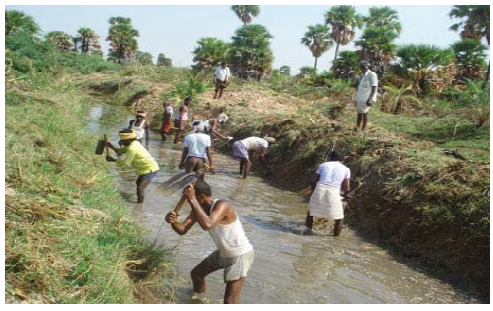
Figure 1 Channel System Irrigation.
This system is widely used in farming irrigation system. As this system is a very low cost system for irrigating a large area farming field. In this system pipes are connected with a water pump and while pump started water flow through pipe a from lake, river, bore well to farming field. And the farmer fully engaged for irrigating the crop field with number of workers. Huge amount of water waste and large number of workers are engaged during watering.
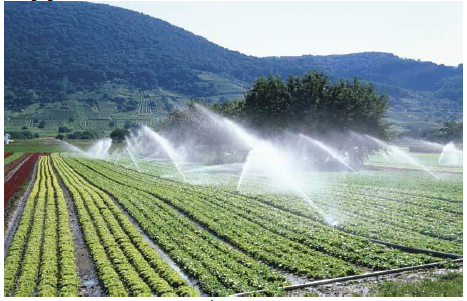
Figure 2 Sprinkler System Irrigation.
This system is more useful whether the water is available in smaller quantity. When pump started then water flow through main pipe and also flow through the perpendicular pipes. A nozzle on the top of perpendicular pipe is joined and rotating automatically at regular intervals. This system is very useful on the sandy soil. Less number of worker required water waste is less.
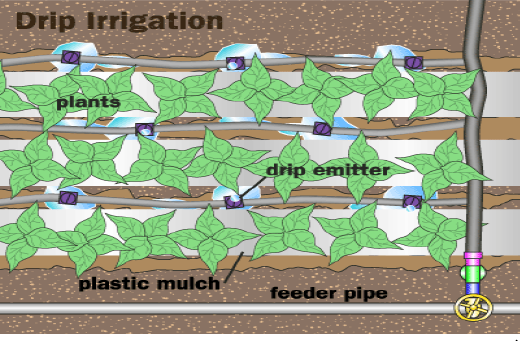
Figure 3 Drip System Irrigation.
In this system waterfall drop by drop at the position of the roots. It is the best technology for watering fruit plants, gardens and trees. Water flow through a main pipe and divided into sub pipes. Special prepared nozzles are attached to these sub pipes.
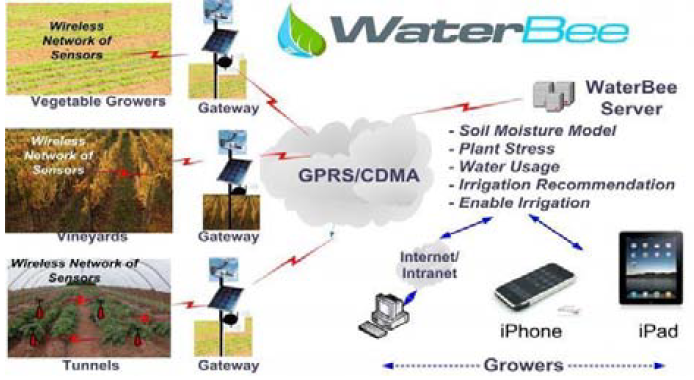
Figure 4 Smart Irrigation System.
Above three systems are generally operate by a user but a smart irrigation tells that the total system is controlled by autonomous mean automatically control the total irrigation system whether the farmer is not present his farm field and send messages to the farmer about the information of farm field and change in operation of the farm field.
SYSTEM COMPONENTS
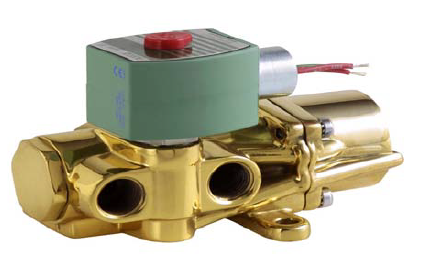
Figure 5 3-way Electro Magnetic Valve.
The solenoid is an electromagnetic part of a valve, comprised of a coil, core tube, core and enclosure. The selection of 2- way, 3-way and 4-waysolenoid valves, designed to handle the most demanding fluid control applications.
3-Way Electromagnetic Valves have three pipe connections and two orifices. When one orifice is open, the other is closed and vice versa.Which is automatically controlled by the water requirement of sensor node.
CONTROL SYSTEM
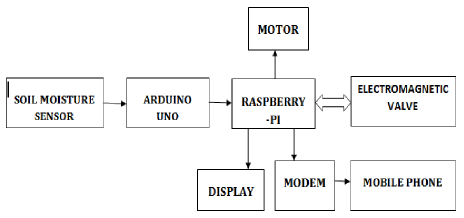
Figure 6 Functional Block Diagram.

Figure 7 Arduino Uno and Soil Moisture Sensor.
Soil moisture sensors are used to sense the moisture level in soil and send the data to wireless network device and the data from network device send to ARDUINO-UNO where an ATMEGA-328 Microcontroller process the data and calculate the percentage of dryness. The sensor data are voltage values so calculating percentage of dryness from voltage values using an algorithm
Voltage = sensor value*(5/1023)
Percent = (voltage/5)*100
The ARDUINO board has 10-bit analog to digital converter.This means that it will map input voltages between 0 and 5 volts into integer values between 0 and 1023.
PROPOSED SYSTEM
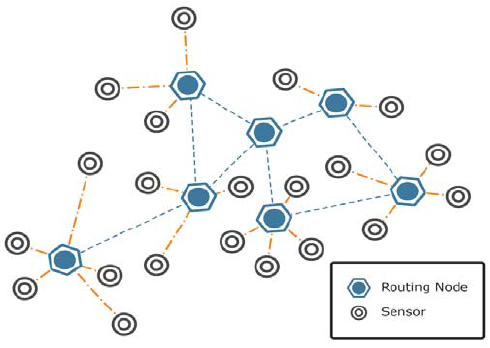
Figure 9.
The sensor nodes and wireless network devices are powered by battery with limited power source. Therefore, the energy consumption of the sensor nodes is treated as the most serious issue for the long operation of the WSN. Clustering WSN devices is an efficient technique which is known for energy saving of the sensor nodes
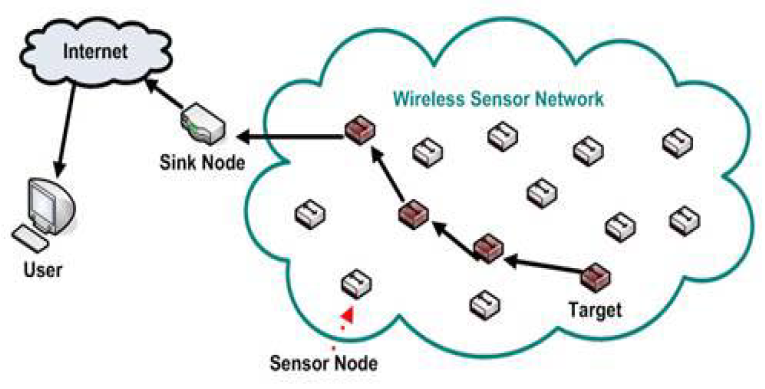
Figure 10.
A two-tire WSN is formed by grouping sensor nodes into clusters in the lower tire. In each cluster there is a cluster head(CH) and remaining nodes are cluster members(CMs). CMs collect the data and send to the CH. The CH then send the aggregated data to the sink directly or via other CH. There are two types of communication between CH and sink i.e., single-hop communication and multi-hop communication.
COST ANALYSIS
In a smart irrigation system there are used a very high cost instruments to control the system. But here we use a very low cost hardwires which are easily a INDIAN farmer buy and implement in farm field. Decreasing the number of sensors are also for a cost effective of the smart irrigation system.
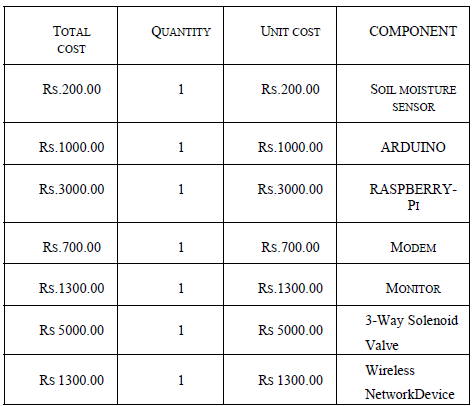
These are the approximation value of the used hardware in a smart irrigation system which total is approximately Rs.15,000.00-20,000.00. This is very low in cost and easily implement in a farm field.
CONCLUSION
In this paper we present a prototype for automatic controlling a irrigation system. Here prototypes includes sensor node and control node. The sensor node is deployed in irrigation field for sensing soil moisture value and the sensed data is sent to controller node.On receiving sensor value the controller node checks it with required soil moisture value. When soil moisture in irrigation field is not up to the required level then the motor is switched on to irrigate associated agriculture field and alert message is send to registered mobile phone.
The experimental results show that the prototype is capable for automatic controlling the experimental results show that the prototype is capable for automatic controlling of irrigation motor based on the feedback of soil moisture sensor. This system is used in a remote area and there are various benefits for the farmers. By using the automatic irrigation system it optimizes the usage of water by reducing wastage and reduce the human intervention for farmers.
It saves energy also as it automatic controlling the system. So there are the system is OFF when the field is wet and automatically start when the field id dry. It is implemented in all type of irrigation system (channel, sprinkler, drip). And we present also less number of sensor nodes to use in a large area of field so the cost of the system also decrease. And power consumption of the wireless network devices are also less and the system perform a long time function.
Source: Sambalpur University
Authors: Chandan kumar sahu | Pramitee Behera
>> More Wireless Projects using Arduino for Engineering Students
>> More Wireless Energy Projects for Final Year Students
>> More Wireless Energy Projects for Final Year Students
>> More Wireless Projects Using Microcontroller for Engineering Students